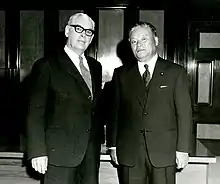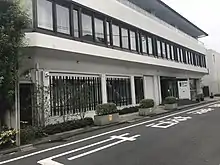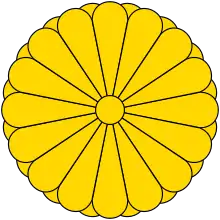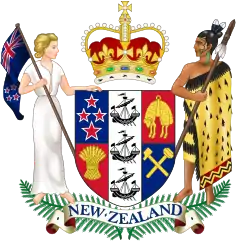Japan–New Zealand relations
Japan–New Zealand relations refers to the diplomatic relations between Japan and New Zealand. Both nations are members of APEC, Australia Group, CPTPP, Organization for Economic Co-operation and Development and the United Nations.
 | |
New Zealand |
Japan |
|---|---|
History


Initial contact between Japan and New Zealand was via London as New Zealand was a part of the British Empire. In 1928, while New Zealand was a self-governing dominion within the British empire; Japan and New Zealand signed a provisional arrangement concerning commerce, customs and navigation.[1] In 1938, Japan opened a consulate in Wellington. During World War II, New Zealand forces fought against Japan, primarily in Singapore, the Solomon Islands and in the waters surrounding Japan.[2] Towards the end of the war, in 1944, New Zealand warships HMNZS Achilles and HMNZS Gambia bombarded the Japanese coast. The war in the Pacific soon ended after the American atomic bombings of Hiroshima and Nagasaki in August 1945.[2]
New Zealand and Australia both favored a harsh treaty with Japan after 1945. However the Australian fear of a Japanese threat was greater, while New Zealand regarded Europe as the most likely area of future conflict. However when Washington desired a softer approach to Japan, New Zealand and Australia both wanted American guarantees for their security. They U.S, provided their goal with the three-way ANZUS Pact signed in San Francisco in September 1951 before the peace conference opened.[3]
In 1952, New Zealand and Japan established diplomatic relations and that same year, New Zealand opened a diplomatic legation in Tokyo. The following year, Japan opened a legation in Wellington.[1] In 1955, Prime Minister Sidney Holland became the first New Zealand head-of-government to pay an official visit to Japan. The visit was reciprocated in 1957 by Japanese Prime Minister Nobusuke Kishi.[1] In 1958 the two nations signed a commercial treaty that set their modern economic relationship. New Zealand showed little interest was in trade with Japan in the 1950s. However it feared losing its British market for agricultural products. It was clear that with mainland China was under hostile Communist control more trade with Japan would be wise.[4]
Since 1958 Japan and New Zealand have developed strong political ties with, common views and a shared interest in the stability, growth and development of the Asia Pacific region.[5] In April 2012, both nations celebrated 60 years of diplomatic relations.[5]
High-level visits
|
|
Bilateral agreements
Both nations have signed several bilateral agreements such as a Provisional Arrangement concerning Commerce, Customs and Navigation (1929); Agreement on Commerce (1958); Agreement on the Avoidance of Double Taxation and the Prevention of Fiscal Evasion with Respect to Taxes on Income (1963); Agreement concerning Reciprocal Waiving of Passport Visas and Passport Visa Fees (1970); Agreement on Fisheries (1978); Agreement on Air Services (1980) and an Agreement on Working holiday visa (1985).[5]
Tourism and Transportation
In 2014, 81,000 Japanese citizens visited New Zealand for tourism. That same period, over 41,000 New Zealanders visited Japan for tourism.[5] There are direct flights between Japan and New Zealand with Air New Zealand.
Trade
In 2016, trade between Japan and New Zealand totaled US$6.4 billion.[6] Japan's main exports to New Zealand include: motor vehicles and electronic goods. New Zealand's main exports to Japan include: aluminium, cheese, kiwifruit and beef.[6]
Resident diplomatic missions
- Japan has an embassy in Wellington, a consulate-general in Auckland and a consular office in Christchurch.[7]
- New Zealand has an embassy in Tokyo.[8]
 Building hosting the Embassy of Japan in Wellington
Building hosting the Embassy of Japan in Wellington Embassy of New Zealand in Tokyo
Embassy of New Zealand in Tokyo
References
- Japan-New Zealand Relations (Basic Data)
- War in the Pacific Page 2 – The war against Japan
- Ann Trotter, "San Francisco treaty making and its implications for New Zealand" Japan Forum (Nov 2003) 15#3 pp 411–23.
- John Singleton, "New Zealand's economic relations with Japan in the 1950s" Australian Economic History Review (1997) 37#1 pp 1–18.
- MFAT: Our relationship with Japan
- MFAT: Japan
- Embassy of Japan in Wellington
- Embassy of New Zealand in Tokyo
Further reading
- Asia New Zealand Foundation. New Zealanders' Perceptions of Asia and Asian Peoples: 1997-2011 (Wellington: Asia New Zealand Foundation, 2013); annual survey.
- Brocklebank, Laurie W. Jayforce. New Zealand and the Military Occupation of Japan, 1945-48. Auckland: Oxford University Press, 1997).
- Harris, Holly. "New Zealand's Identity and New Zealand-Japan Relations: 1945-2014." (Thesis, Victoria University of Wellington, 2015) online.
- Iwami, Tadashi. "Strategic partnership between Japan and New Zealand: foundation, development and prospect." Pacific Review (2020): 1-28. https://doi.org/10.1080/09512748.2020.1769156
- Kennaway, Richard. New Zealand foreign policy, 1951-1971 (1972) online
- Kennedy, Ian. Japan and New Zealand: Adding Value (Wellington: Victoria University Press for the Institute of Policy Studies, 1992).
- McGee, Alan, et al. "Japanese language education in New Zealand: An evaluative literature review of the decline in students since 2005." (2013). online
- McKinnon, Malcolm. Independence and foreign policy: New Zealand in the world since 1935 (Auckland University Press, 2013).
- McNeil, Ken. "New Zealand through a Japanese glass 1869–1944." Japan Forum (2006) 18#1 pp 23–43
- Peren, Roger. Japan and New Zealand 150 Years (Tokyo: New Zealand Centre for Japanese Studies, 1999).
- Ryan, Greg. "‘He is Our Opponent, Not Our Enemy’: Two Rugby Tours and Australasian Perceptions of Japan during the 1930s." International Journal of the History of Sport 36.12 (2019): 1076-1095.
- Trotter, Ann. "Coming to Terms with Japan: New Zealand's Experience, 1945--63" in Conflict and Amity in East Asia: Essays in Honour of Ian Nish: ed by T.G. Fraser and Peter Lowe, (1992) pp 125–142.
- Trotter, Ann. New Zealand and Japan 1945-1952: the occupation and the peace treaty (A&C Black, 2013).
- Wallace, Corey. "Dealing with a Proactive Japan: Reconsidering Japan’s Regional Role and Its Value for New Zealand’s Foreign Policy." in Small States and the Changing Global Order (Springer, Cham, 2019) pp. 193-211.
- Wevers, Maarten. Japan, Its Future, and New Zealand (Wellington: Victoria University Press for the Institute of Policy Studies, 1988).

